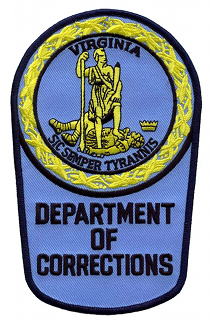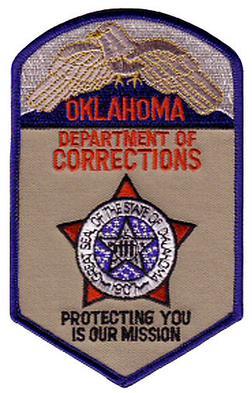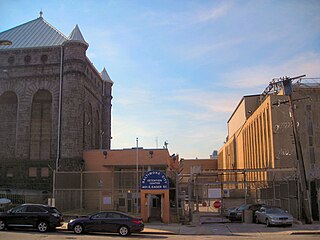
Jessup is an unincorporated community and census-designated place in Howard and Anne Arundel counties, about 15 miles (24 km) southwest of Baltimore, Maryland, United States. Per the 2020 census, the population was 10,535.

A super-maximum security (supermax) or administrative maximum (ADX) prison is a "control-unit" prison, or a unit within prisons, which represents the most secure level of custody in the prison systems of certain countries.

CoreCivic, formerly the Corrections Corporation of America (CCA), is a company that owns and manages private prisons and detention centers and operates others on a concession basis. Co-founded in 1983 in Nashville, Tennessee by Thomas W. Beasley, Robert Crants, and T. Don Hutto, it received investments from the Tennessee Valley Authority, Vanderbilt University, and Jack C. Massey, the founder of Hospital Corporation of America.
North Branch Correctional Institution (NBCI) is a high-tech, maximum security prison or "hyper-max prison" operated by the Maryland Department of Public Safety and Correctional Services in Cresaptown, unincorporated Allegany County, Maryland, near Cumberland.

The Tennessee Department of Correction (TDOC) is a Cabinet-level agency within the Tennessee state government responsible for the oversight of more than 20,000 convicted offenders in Tennessee's fourteen prisons, three of which are privately managed by CoreCivic. The department is headed by the Tennessee Commissioner of Correction, who is currently Frank Strada. TDOC facilities' medical and mental health services are provided by Corizon. Juvenile offenders not sentenced as adults are supervised by the independent Tennessee Department of Children's Services, while inmates granted parole or sentenced to probation are overseen by the Department of Correction (TDOC)/Department of Parole. The agency is fully accredited by the American Correctional Association. The department has its headquarters on the sixth floor of the Rachel Jackson Building in Nashville.

The Chesapeake Detention Facility (CDF), previously the Maryland Correctional Adjustment Center (MCAC), is a maximum level II prison operated by the Maryland Department of Public Safety and Correctional Services in Baltimore.

The Virginia Department of Corrections (VADOC) is the government agency responsible for community corrections and operating prisons and correctional facilities in the Commonwealth of Virginia in the United States. The agency is fully accredited by the American Correctional Association and is one of the oldest functioning correctional agencies in the United States. Its headquarters is located in the state capital of Richmond.

The Hawaii Department of Public Safety is a department within the executive branch of the government of the U.S. state of Hawaii. It is headquartered in the 919 Ala Moana Boulevard building in Honolulu, Hawaii. The Department of Public Safety is made up of three divisions: Administration, Corrections, and Law Enforcement.


The Oklahoma Department of Corrections is an agency of the state of Oklahoma. DOC is responsible for the administration of the state prison system. It has its headquarters in Oklahoma City, across the street from the headquarters of the Oklahoma Department of Public Safety. The Board of Corrections are appointees: five members are appointed by the Governor; two members are appointed by the President Pro Tempore of the Senate; and two members are appointed by the Speaker of the house of Representatives. The board is responsible for setting the policies of the Department, approving the annual budget request, and working with the Director of Corrections on material matters of the agency. T. Hastings Siegfried is the current chairman of the board. The director, who serves at the pleasure of the governor, is the chief executive of the department. The current director of Corrections is Scott Crow, who was appointed after Director Joe Allbaugh resigned his post on June 13, 2019. Crow was confirmed by the Oklahoma State Senate as director in May 2020.

The Maryland Metropolitan Transition Center (MTC), formerly known as the historic "Maryland Penitentiary", is a maximum pre-trial security Maryland Department of Public Safety and Correctional Services prison located in Baltimore facing Greenmount Avenue between Forrest Street and East Madison Street. It was established in 1811 as the first prison in the state and the second of its kind in the country and the original buildings faced towards East Madison Street above the east bank of the Jones Falls stream and adjacent to the old stone walls of the Baltimore City Jail, earlier established in 1801, rebuilt in 1857–1859, and later in 1959–1965.

The Department of Public Safety and Corrections (DPS&C) is a state law enforcement agency responsible for the incarceration of inmates and management of facilities at state prisons within the state of Louisiana. The agency is headquartered in Baton Rouge. The agency comprises two major areas: Public Safety Services and Corrections Services. The secretary, who is appointed by the governor of Louisiana, serves as the department's chief executive officer. The Corrections Services deputy secretary, undersecretary, and assistant secretaries for the Office of Adult Services and the Office of Youth Development report directly to the secretary. Headquarters administration consists of centralized divisions that support the management and operations of the adult and juvenile institutions, adult and juvenile probation and parole district offices, and all other services provided by the department.
The Miami-Dade Corrections & Rehabilitation Department (MDCR) is a County Department serving all of Miami-Dade County's 30 municipal police departments, the county police department (MDPD), as well as state agencies. The MDCR is the 7th largest county jail system in the United States, with approximately 2,906 employees. [FY 2009–10] The Department is still often referred by its former name, DCJ for Dade County Jail. Miami-Dade Corrections Officers are easily identified by their white shirts with green trousers with gray stripe. Miami-Dade Corrections vehicles are identified by their green and white livery. MDCR officers carry silver badges, while officers with the ranks of sergeant and above carry gold badges. The badge is exactly the same as the Miami-Dade County Police Department to reflect the fact that they were at one time one entity. The MDCR operates six detention facilities with a system-wide average of approximately 7,000 inmates, and books approximately 114,000 inmates annually. Several facilities are nationally accredited by the American Correctional Association, as well as at the state level by the Florida Corrections Accreditation Commission. The current director of the department is Daniel Junior, who was appointed by Miami-Dade Mayor Carlos Giménez. The Department's headquarters is located at 2525 NW 62nd Street, Miami, Florida.

The New Youth Detention Facility in Baltimore City is a jail planned by the Maryland Department of Public Safety and Correctional Services (DPSCS). The facility is slated to be built between the 600 blocks of East Monument and East Madison Streets.

The Howard County Department of Corrections (HCDC) is the corrections agency servicing 3500 arrests within 252.04 square miles (652.8 km2) of Howard County, Maryland yearly.

Baltimore City Detention Center is a Maryland Department of Public Safety and Correctional Services state prison for men and women. It is located on 401 East Eager Street in downtown Baltimore, Maryland. It has been a state facility since July 1991.
Jessup Correctional Institution (JCI) is a maximum security prison operated by the Maryland Department of Public Safety and Correctional Services in Jessup, Maryland. It was formerly called the Maryland House of Correction-Annex.

The Western Correctional Institution is a maximum security state prison for men located in Cumberland, Allegany County, Maryland. It opened in 1996 and has an official capacity of 1793.
The Eastern Correctional Institution (ECI) is a medium-security state prison for men located in Westover, Somerset County, Maryland, owned and operated by the Maryland Department of Public Safety and Correctional Services. Eastern has a minimum-security Annex, completed in 1993, and housing some 560 inmates. The total capacity of the minimum- and medium-security sections is around 3,400. With an actual population of about 3,300, this is Maryland's largest prison.



















